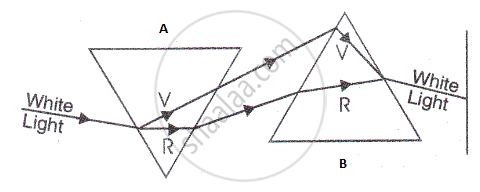Advertisements
Advertisements
प्रश्न
When a beam of white light is passed through a prism, it splits to form lights of seven colours. Is it possible to recombine the lights of seven colours to obtain the white light again? Explain your answer.
उत्तर
When a beam of white light is passed through a prism, it splits to form lights of seven colours. It is possible to recombine the lights of seven colours to obtain white light again.
Recombination of colours to form white light again is possible if a second glass prism is placed upside down behind the first prism. A patch of white light is obtained on a screen placed behind the second prism because the refraction produced by the second prism is equal and opposite to the refraction produced by the first prism.
APPEARS IN
संबंधित प्रश्न
Define the term dispersion of white light.
What is a rainbow? What are the two conditions necessary for the formation of a rainbow in the sky?
A beam of white light is shone onto a glass prism. The light cannot be:
(a) deviated
(b) dispersed
(c) focused
(d) refracted
Which is optically denser: water or air? Give reason
In an experiment to trace the path of a ray of light through a triangular glass prism, a student would observe that the emergent ray
(a) is parallel to the incident ray.
(b) is along the same direction of incident ray.
(c) gets deviated and bends towards the thinner part of the prism.
(d) gets deviated and bends towards the thicker part (base) of the prism.
In an experiment to trace the path of a ray of light through a glass prism for different values of angle of incidence a student would find that the emergent ray:
(A) is parallel to the incident ray
(B) perpendicular to the incident ray
(C) is parallel to the refracted ray
(D) bends at an angle to the direction of incident ray
When we place a glass prism in the path of a narrow beam of white light a spectrum is obtained. What happens when a second identical prism is placed in an inverted position with respect to the first prism? Draw a labelled ray diagram to illustrate it.
If white light is used in same way what change is expected in the emergent beam?
Complete the ray diagram given below to show the nature of light produced on the screen.
The completed ray diagram is as shown below:

An object AB is placed in front of a convex lens as shown in fig. 4. Complete the ray diagram and obtain the image formed and state the nature of the image.

